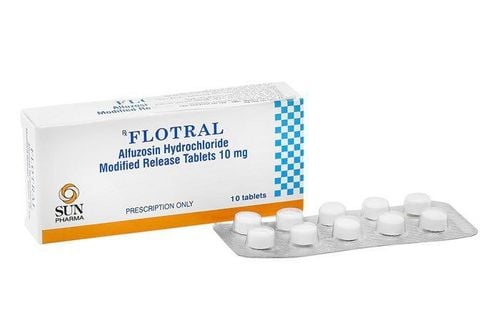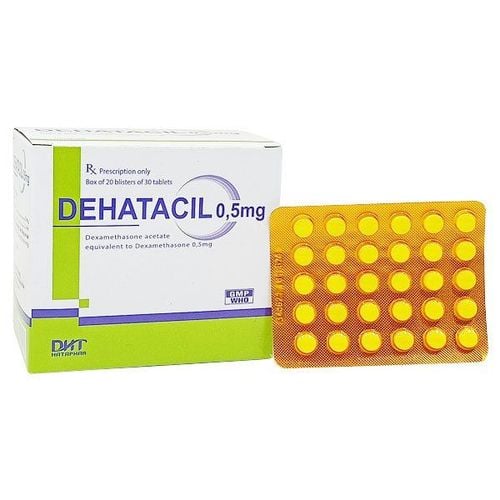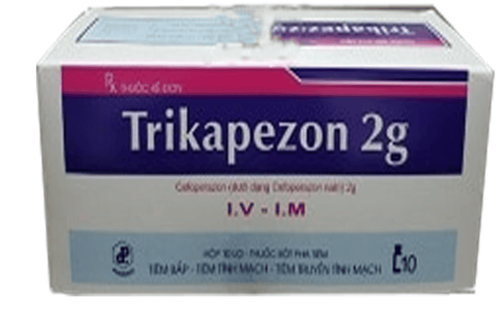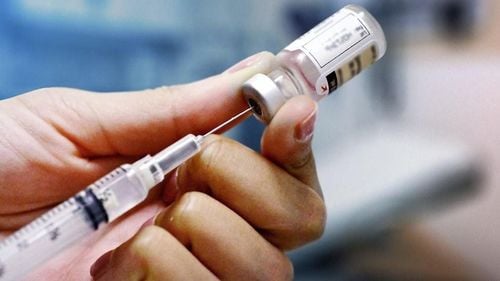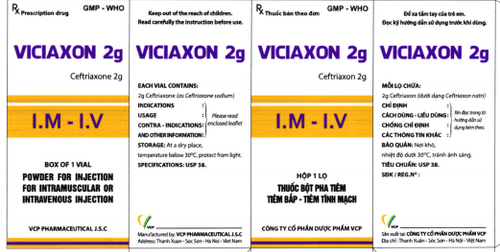This is an automatically translated article.
Aximaron is a prescription antibiotic. Let's find out more about Aximaron antibiotic how to use? What is the dose of Aximaron? What should Aximaron pay attention to when using,... right after.1. What is Aximaron?
Aximaron belongs to the list of antibiotics, antiparasitic, antifungal, antiviral drugs. Aximaron is manufactured by Samik Pharma Co., Ltd - Korea, under registration number VN - 13625 - 11.
The ingredient in Aximaron is the active ingredient Ceftriaxone Sodium with a content of 1g. Aximaron is prepared as a powder for injection, each box has 10 vials.
2. Uses of Aximaron
Aximaron contains the main ingredient Ceftriaxone Sodium with a content of 1g. This is a 3rd generation antibiotic of the Cephalosporin group. Aximaron is a broad spectrum antibacterial drug that is administered as an injection.
Aximaron kills bacteria by inhibiting cell wall synthesis. Mechanism of action Aximaron binds to one or more penicillin-binding proteins. This protein is involved in the composition of bacterial cell membranes. Thus, they inhibit the final step of cell wall biosynthesis and effectively kill bacteria.
Similar to 3rd generation Cephalosporins (cefotaxime, ceftazidime,...) Aximaron antibiotics have in vitro activity against Staphylococci strains less than 1st generation Cephalosporins. However, they are effective at killing bacteria. Gram (-) bacteria is wider than the 1st and 2nd generation Cephalosporins.
Ceftriaxone - the active ingredient in Aximaron is not absorbed from the gastrointestinal tract, so it must be administered intravenously or intramuscularly. After injection of Aximaron, the active ingredient Ceftriaxone will be distributed into tissues and body fluids. Drug concentrations peak about 2 hours after intramuscular injection, 30 minutes after intravenous infusion.
3. Indication of Aximaron
Aximaron is indicated in the following cases:
Respiratory infections; Ear - nose - throat infections; Kidney infection - urogenital tract; Septicemia ; Meningitis ; Prophylaxis of postoperative infections; Bone and joint infections; Skin and soft tissue infections; Peritonitis ; Bacterial digestive infections; Typhoid; Gonorrhea; Syphilis ; ... Aximaron is safe when used as indicated.
4. Dosage - How to take Aximaron
Aximaron is safe to use when used correctly and in the correct dose as directed.4.1. How to take Aximaron?
Aximaron is in the form of a powder for injection, so the way to use the drug is by injection / intravenous infusion according to the instructions.4.2. Dosage of Aximaron
According to the manufacturer's recommendation, Aximaron antibiotics should be used according to the following dosage:
Adults Use dose of Aximaron 1 - 2g x 2 times/day. The dose of Aximaron can be adjusted up to 4g. The dose of Aximaron to prevent infection in surgery is 1g as a single dose before surgery. Children The dose of Aximaron is according to kg of body weight, accordingly, the dose for children is 50 - 75mg/kg x 2 times. The total dose of Aximaron antibiotic should not exceed 2g/day. Neonates receive a dose of 50mg/kg body weight/day. In addition, the dose of Aximaron also depends on each specific condition such as:
Treatment of meningitis, dose of Aximaron 100mg/kg body weight. Maintain a total dose of 100 mg/kg body weight. Aximaron is injected once a day for 7-14 days; Combined renal/hepatic impairment: Dosage adjustment is required when taking Aximaron. Adjusted based on creatinine clearance. If the creatinine clearance is less than 10ml/min, the dose of Aximaron should not exceed 2g/24 hours; Hemodialysis: A dose of Aximaron 2g given at the end of dialysis may be sufficient to maintain effective Aximaron concentrations until the following dialysis session. Usually 72 hours;
5. Contraindications Aximaron
Do not use Aximaron for subjects who are hypersensitive or allergic to the ingredients in Aximaron such as Ceftriaxone / Cephalosporin , Penicilline.
6. Aximaron side effects
When injecting Aximaron you may also experience some side effects such as:
Allergies; Rash/urticaria ; Diarrhea; Fever; Phlebitis; Edema; Thrombocytopenia ; Leukopenia; Eosinophilia; Headache; Dizzy; Anaphylaxis; Blood clotting disorders; Anemia; Agranulocytosis; Pseudomembranous colitis; Blood in urine; Increased serum creatinine; ... Monitor and notify the doctor/pharmacist when there are abnormal manifestations while taking Aximaron.
7. Aximaron . interaction
When using Aximaron you may also encounter some interactions if used with other drugs such as:
Gentamicin ; Colistin; Furosemide; Probenecid; Aminosides; ... When using Aximaron, for the best safety, you should inform your doctor/pharmacist of the drugs you are using for advice.
8. Caution Aximaron
Some precautions given by the manufacturer when using the antibiotic Aximaron include:
Check carefully the history of drug allergy, especially Cephalosporin / Penicillin / other drugs; Renal failure requires adjusting the dose of Aximaron when used; Combined renal/liver failure must monitor the plasma concentration of Aximaron; Children under 30 months do not receive Aximaron injection by intramuscular route; ... Care should be taken when using the antibiotic Aximaron.
9. Pregnant women, nursing mothers, driving and operating machines using Aximaron
Use caution when administering Aximaron to pregnant women; Breastfeeding consult your doctor when taking the antibiotic Aximaron; Driving and operating machinery may use Aximaron;
10. Preservation of Aximaron
Aximaron antibiotic preserved according to instructions.
Thus, the antibiotic Aximaron is an injectable drug. Aximaron should be used as directed by your doctor. Aximaron drug interactions are complicated, so caution should be taken.




